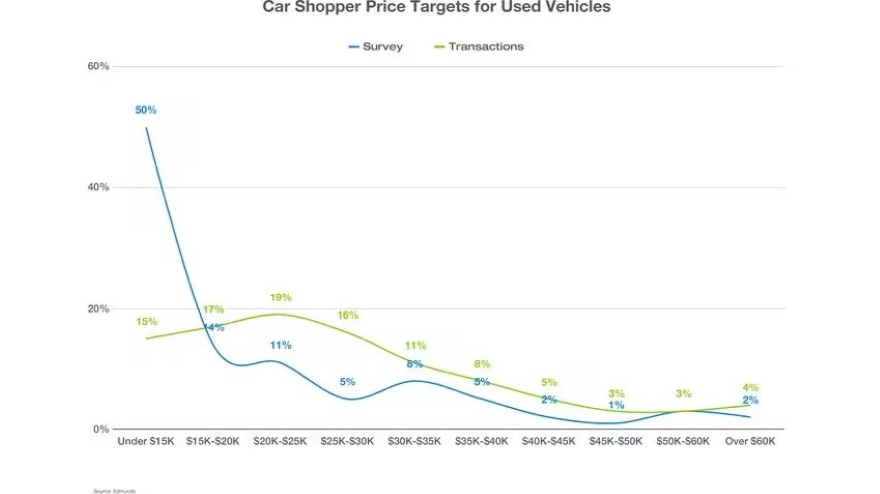Edmunds report finds car shoppers’ perceptions lead to sticker shock

Image courtesy of Edmunds.
By subscribing, you agree to receive communications from Auto Remarketing and our partners in accordance with our Privacy Policy. We may share your information with select partners and sponsors who may contact you about their products and services. You may unsubscribe at any time.
Sticker shock is real.
That’s the message of a new report from Edmunds head of insights Jessica Caldwell that examines the disconnect between what car shoppers want to pay for their next vehicle and what the market says they’ll have to pay.
The analysis is based on Edmunds’ data on new- and used-vehicle transactions, and the results of a consumer sentiment survey conducted in August among car shoppers who have purchased a vehicle previously and have indicated they’re planning to purchase a vehicle in the next 12 months.
While vehicle prices are coming down from their post-COVID peaks, they’re still well above pre-pandemic levels. And the many consumers who are coming back to the market for the first time since then are surprised by what they find.
Caldwell pointed to Edmunds data that shows the average trade-in age for a new vehicle is approximately six years, “which means a significant number of car shoppers returning to showrooms this year last purchased a car in 2018,” she said in the Car Shopper Expectations vs. Market Realities report. “Perhaps not so shockingly, much has changed for car buyers since then.
“This means that consumers are likely coming back to the market with skewed perceptions of affordability based on their last car-shopping experiences.”
Subscribe to Auto Remarketing to stay informed and stay ahead.
By subscribing, you agree to receive communications from Auto Remarketing and our partners in accordance with our Privacy Policy. We may share your information with select partners and sponsors who may contact you about their products and services. You may unsubscribe at any time.
In the used space, the survey found 64% of prospective used-car buyers said they’d like to spend less than $20,000 on their next vehicle, 50% were looking to spend $15,000 or less and 27% had $10,000 as their target price.
But the reality is a mere 5% of all used-vehicle transactions in July were for $10,000 or less, and the average transaction price for all used vehicles sold in July was $26,936, according to Edmunds’ data.
In addition, 76% of shoppers said the highest interest rate they’d be willing to accept for a used-vehicle purchase was between 0 and 4.99%, when in the real world, according to Edmunds, six of 10 car buyers who financed a used-vehicle purchase agreed to an interest rate between 6% and 11%, and the average APR for all financed used purchases was 11.4%.
Among new-car shoppers, 48% said they’d like to spend $35,000 or less on their next vehicle and 14% said they’d like to spend $20,000 or less, but Edmunds’ data showed the average new-vehicle purchase price in July was $47,716, and there were “nearly zero” new vehicle transactions under $20,000.
Caldwell said that clearly shows “affordability concerns among American car shoppers aren’t going away anytime soon.”
“Even as the new- and used-vehicle markets continue to normalize,” she explained, “car shoppers are still facing historically harsh purchasing conditions and those returning to showrooms for the first time in years are likely going to experience major sticker shock.
“In response, consumers are likely being forced into making trade-offs such as selecting a different brand of vehicle, an older vehicle or a different-sized vehicle unless they allocate more to their vehicle budget, which isn’t always feasible.”
In fact, the survey showed they’re having to sacrifice more than that.
More than 73% of respondents said they’ve already held off on buying a vehicle because of high vehicle prices, and more than 62% have done so due to high interest rates. More than half (51%) said they planned to put off other expenditures in order to afford a vehicle, including a vacation (29%), basic monthly needs (15%), a home purchase (11%), a new mobile phone/electronic device (10%) and medical procedures (5%).
And 54% of survey respondents said they planned to work more hours and/or take on an additional job to afford a vehicle.
Caldwell said the good news for the auto industry is many consumers are aware of those challenges – 65% of survey respondents said their current car purchase seems more challenging than their previous ones.
“But,” she said, “it’s critical for automakers and dealers to know the perception gap exists in order to offer a level of compassion for customers. After all, these are people making real sacrifices in order to afford a vehicle, which is making the car-shopping process more stressful than ever.”
Read the full report here.


